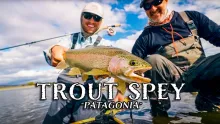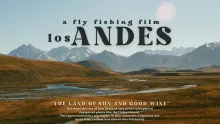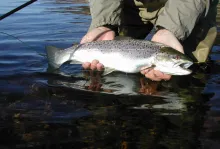Argentinean fly-fisher Pedro Alfredo Miles has visited that most famous of all South American rivers again - Rio Grande.
Once again this year I fished the Rio Grande in Tierra del Fuego, Argentina. I stayed at Danny Lajous' Despedida Lodge, on the Estancia Despedida (farewell in Spanish).
In spite of
the desolate appearance of the steppes, they have a variety of wild life. Hundreds of guanaco are seen as well as condors either riding the thermals or feeding on carrion; beavers and muskrats and cheeky foxes that come very close to sniff our nets and picnic hampers looking for snacks. But above all, in my book, those wondrous fish that after several years growing up in the sea, unerringly return to their birthplace to spawn.
The Rio Grande
flows east from its headwaters in Chilean Tierra del Fuego into the food rich waters of the South Atlantic Ocean around 54 deg. south. It is smaller than its name implies, 20 to 40 meters wide with pools of up to about 4 meters deep. The bottom is mostly shale, pebbles and sand though it has riffles and runs with freestone and some larger rocks. It is easy to wade and in certain spots can be crossed with water up to the waist.
The banks
are sandy soils with the hardy vegetation of the Patagonian steppes. In places the river has cut into the banks and knocked clumps of this earth into the river. The remains of this vegetation in the water are home to a variety of scuds on which resident trout and young sea trout feed. These and the many natural pools help form the lays where the sea run brown trout rest on their way upstream to their spawning waters.
During late spring
, October and November, a growing number of King Salmon swim up the Grande to its headwaters in Chile to spawn. The effect these salmon will have on the Brown Trout is as yet unknown. Some local specialists worry about whether the hungry smolts on their way down river to the sea will have a negative effect on the population of young browns and their food.
This year
(2014) we went earlier in the season (mid February) to try to catch sea run browns fresh from the sea.
Strong winds are a constant in southern Patagonia so as usual it was windy, but with advantages, with a rough surface on the water the fish are easier to fool.
We fished
both the Rio Grande and the Rio Menendez, the Grande's main tributary. Despedida has a long stretch on the southern bank of the Rio Grande as well as the eastern bank of the Rio Menendez. On the north bank is Estancia María Behety and upstream, also on the southern bank is Kau Tapen Lodge with the Rio Menendez the limit with Despedida. Further upstream is Estancia Aurelia that also has a fishing lodge.
Instead of running
sheep as do most of Patagonia's estancias, Despedida breeds cattle and have a magnificent herd of polled Herefords.
The lodges
that share the river have arranged a calendar by which each lodge uses the major pools exclusively on different days of the week. In this way there are never more than two or three anglers fishing the same pool at the same time.
The water
was lower and clearer than when we came last year in mid March. This meant smaller flies and finer tippets, 15 to 20 lbs. The conditions were such that I started out with a # 7 11 foot switch rod with a Scandi line but soon changed to a 9 foot #8 single hand rod with a sinking line with a 7 inch per second (ips) sinking tip. I used this rod and line during most of my stay.
Fish fresh from the sea
are a lot friskier, perhaps more willing to take a fly as maybe sex does not occupy all their mind yet. The largest I caught, a 17 pound female, gave battle for almost half an hour. We were both pretty tired when it ended. Additionally fresh fish have not yet felt a hook setting in their mouth so are not as wary.
On the Rio Menendez
we caught some very large fish with a dry fly, most of these a Tarantula Pattern with rubber legs tied on #6 hooks. The biggest was caught by my friend Federico Prato, a 19 pound male.
Most of the fish
caught by my party took scud patterns, initially several fish were lost to straightened or broken hooks as we used the scud patterns in our boxes tied on light hooks 6, 8 and 10. Fortunately I had taken some heavy hooks for my tube flies, Daichi's 1650 #6, so we borrowed the lodge's tying table and prepared olive colored scuds with a dab of bright green ice dubbing as a head. These worked beautifully though stronger hooks do not rule out tippet cuts, I lost a big fish as did not give it enough slack when it leaped out of the water.
Another of my memorable catches
, a 12 lb female, took my scud at the tail of one of the many good pools we fished and chased down stream to that wonderful sound of a singing reel; I was only able to stop the run after going 30 meters into my backing.
We caught fish all day, but magic time is the late afternoon and evening, which on these latitudes is 8:00 to 9:30 pm.
We also
did a lot of experimenting fly patterns, amongst them dry flies fished as nymphs on sinking lines. These smaller patterns were a magnet for young trout in sizes from 5 to 10 inches of which I caught one on every retrieve though shallower water.
Schools of sea trout
were seen moving upstream during daylight, a very unusual sight. It would appear that these had been dislodged from their lays downstream by the numerous sea trout coming in from the sea, taking advantage of the higher tides due to the full moon.
There was some controversy
on last year's article on this river, particularly concerning free access to the river. In this respect I would like to make the following considerations. Because of the low productivity of the Patagonian steppes, these properties are huge; most of the ones on the Rio Grande are over 40 square miles, with a few over 100 square miles. In the past the size of an estancia was not measured by its surface but by the amount of sheep it could carry. There are very few public roads in the area and these, barring a couple of exceptions, do not go anywhere near the river. Therefore access to the river is a long distance through private property.
Though fishing supplements
the income of these estancias, their principal activity is the production of sheep and/or cattle. To be able to do this efficiently they have hundreds of miles of fences and many gates. These gates have to remain closed at all times to ensure livestock remain where they are supposed to as grass management is vital. If overgrazed, recovery in this delicate environment could take decades. To offer unlimited access (to responsible anglers or anybody else), the main gates would have to be left unlocked putting at risk their assets, not only from theft but an open gate always means trouble.
To allow anglers that are not staying at the lodges to fish the river, the local fly fishers association and reputed Rio Grande guides can arrange access with the owners of the estancias.
I would like
to express my appreciation to Federico Prato, fellow angler and photographer for allowing me to use his photographs in this article.
- Log in to post comments
























